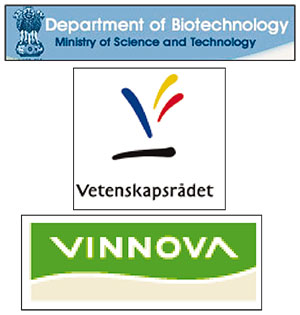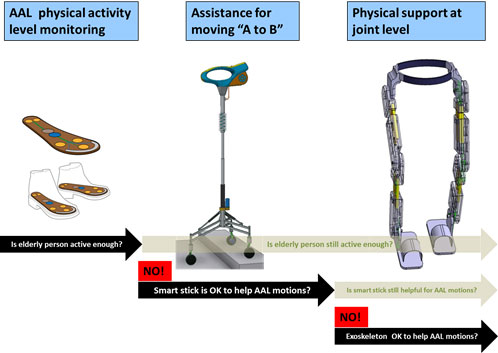Address: Department of Signal Processing, School of Electrical Engineering, KTH, Osquldas väg 10, SE-100 44 Stockholm, Sweden
Web page: http://www.kth.se/en/ees/omskolan/organisation/avdelningar/sp
Contact person: Professor Peter Händel, Department Head, phone: +46-8-790 75 95
 The department’s research activities span from fundamental research in signal processing and information theory to applied research in wireless systems, digital communications, navigation, measurement technology, and real-time implementation. In collaboration with the Communication Theory Lab, the Signal Processing Lab is responsible for education in the signal processing and communication areas. Fourteen undergraduate courses are given every year, most of them at masters level. The division is also responsible for a two-year masters program in Wireless Systems, which is the most popular one at KTH. Approximately 25 master theses are completed annually in this area.
The department’s research activities span from fundamental research in signal processing and information theory to applied research in wireless systems, digital communications, navigation, measurement technology, and real-time implementation. In collaboration with the Communication Theory Lab, the Signal Processing Lab is responsible for education in the signal processing and communication areas. Fourteen undergraduate courses are given every year, most of them at masters level. The division is also responsible for a two-year masters program in Wireless Systems, which is the most popular one at KTH. Approximately 25 master theses are completed annually in this area.
The School of Electrical Engineering also coordinates two higly reputed competence centres for strategic research, the ACCESS Linnaeus Center in communication networks; and the Swedish Centre for Smart Grids and Energy Storage (SweGRIDS).
South Asia related activities
 The department is strongly involved in research collaboration with India. In 2010, the Swedish Governmental Agency for Innovation Systems (Vinnova), and the Department of Science and Technology (DST), Government of India announced a Strategic Indo-Swedish Cooperative Research Programme in the field of Embedded Systems.
The department is strongly involved in research collaboration with India. In 2010, the Swedish Governmental Agency for Innovation Systems (Vinnova), and the Department of Science and Technology (DST), Government of India announced a Strategic Indo-Swedish Cooperative Research Programme in the field of Embedded Systems.
Researchers from ACCESS, led by Prof. Peter Händel, were selected for funding along their Indian collaboration partner institution, the Indian Institute of Science (IISc) in Bangalore, for a major project on ”Testing Indoor Positioning”, research carried out in KTH’s closed nuclear reactor facility in Stockholm, 15 meters below earth. This technology developed at KTH will save more lives from fires while making the work of a firefighter safer. A small embedded computer in the heal of the firefighter’s shoe allows for the leader of the rescue operation to follow the firefighters movements and location throughout the coordinated rescue operation – without any infrastructure (see a youtube presentation).
The project was funded for the period 2011-2013. In September 2011, Kapil Sibal, India’s Minister of IT visited the testing site and the research team at KTH. They were shown around by Prof. Peter Händel, and Prof. Rajeev Thottappillil, KTH then academic coordinator for India. (Peter Händel and Kapil Sibal on photo above along with Indian Ambassador Ashok Sajjanhar. Photo by Christer Gummeson).
Read an article about the visit, entitled ”KTH en del av lösningen”.
Indo-Swedish research and innovation collaboration in the field of Health
 In December 2013, the KTH School of Electrical Engineering (EES) at KTH was selected for funding from the Strategic Indo-Swedish Cooperative Innovation Programme, jointly administered by The Department of Biotechnology, Government of India (DBT); the Swedish Governmental Agency for Innovation Systems (VINNOVA); and the Swedish Research Council (SRC). The project, to be carried out in collaboration with the Indian Institute of Science (IISc) in Bangalore; and Indian Institute of Technology (IIT) Kanpur, is entitled ”Seamless Affordable Assistive Technology for Health (SAATH)”, and it receives SEK 5 m. for the period 2014 – 2016. The project leaders are Professor Peter Händel, KTH; and Professor Bishakh Bhattacharya, Dept. of Mechanical Engineering, IIT Kanpur. Professor K.V.S. Hari at the Department of Electrical Communication Engineering, IISc, is also involved. More information about the project.
In December 2013, the KTH School of Electrical Engineering (EES) at KTH was selected for funding from the Strategic Indo-Swedish Cooperative Innovation Programme, jointly administered by The Department of Biotechnology, Government of India (DBT); the Swedish Governmental Agency for Innovation Systems (VINNOVA); and the Swedish Research Council (SRC). The project, to be carried out in collaboration with the Indian Institute of Science (IISc) in Bangalore; and Indian Institute of Technology (IIT) Kanpur, is entitled ”Seamless Affordable Assistive Technology for Health (SAATH)”, and it receives SEK 5 m. for the period 2014 – 2016. The project leaders are Professor Peter Händel, KTH; and Professor Bishakh Bhattacharya, Dept. of Mechanical Engineering, IIT Kanpur. Professor K.V.S. Hari at the Department of Electrical Communication Engineering, IISc, is also involved. More information about the project.
A Call for the programme was announced in the spring 2013, and decisions were taken in December 2013. Altogether five Indo-Swedish projects in the field of Health and Disease prevention were selected to receive funding. Full information about the selection.
The goal of the programme is to support long-term Indo-Swedish research and innovation collaboration in the field of Health. Indian and Swedish industry and researchers in both private and public sectors were invited to submit joint project applications for collaborative research and innovation projects. The approach is to establish and strengthen collaborative industry and research networks between India and Sweden by funding joint research and innovation projects, exchange visits, demonstration and proof of principle.
The SAATH project is a kind of continuation of the previous Vinnova project, but is more focused on practical mass use of the devices that have now become cheaper to produce. It is also extended to include rollators, sticks and so called exoleg, with Swedish partner institutions Gävle University, Robotdalen, and Brepus Castel AB. In India, similarly, the company GT Silicon in Kanpur is involved.
 Project description: To develop wireless sensor based systems for monitoring activity-level, providing physical assistance and “critical” exercise of elderly people during normal daily living using a combination of sensors, assisted reconfigurable smart walking sticks, and “physical-helper” exoskeletons with an emphasis on safe and secure mobility in the home and beyond to enable independence and active living for maximum possible span of life.
Project description: To develop wireless sensor based systems for monitoring activity-level, providing physical assistance and “critical” exercise of elderly people during normal daily living using a combination of sensors, assisted reconfigurable smart walking sticks, and “physical-helper” exoskeletons with an emphasis on safe and secure mobility in the home and beyond to enable independence and active living for maximum possible span of life.
SAATH will use real-world scenarios of mobility degradation due to ageing and how this affects the normal daily activities of elderly persons in India and Sweden. The project covers the full range of requirements from basic physical activity monitoring to identify need for supportive action, and, once this has been identified, to provide a variety of physical assistance to meet this need as it grows due to the ageing process (from smart sticks to help a person move from one place to another; to wearable exoskeletons to help specific joints for performing normal human motions). SAATH extends current and previous projects of the partners to allow the various solutions to be integrated into the assistive SAATH solutions via a flexible modular approach (to be developed and agreed) to facilitate scalability of the evolving assistance that is provided to meet individual needs due to ageing. SAATH focuses on the following areas to meet these objectives:
1) Monitoring system to determine physical activity levels and, if this falls below a minimum level for normal active living, trigger a need for physical assistance aids.
2) Deployment of a smart mobility stick to provide physical support to help an elderly person perform simple transfers and to move from point A to point B and increase overall physical activity levels to remain within acceptable norms.
3) When the smart mobility stick is insufficient, include the use of a physical assistant exoskeleton for helping move specific human lower body joints (hips, knees and ankles) via natural interfaces to perform normal human movements needed in AAL activities in a safe and secure manner, eg. sit-to-stand and vice versa, walking on flat ground, walking on uneven ground, stairs, stable standing, etc.
A SAATH modular and scalable personal care system technology for safe and secure mobility in the home and beyond, will be designed, developed, demonstrated and commercialisation plans commenced.